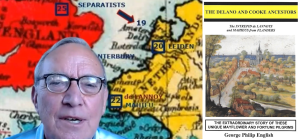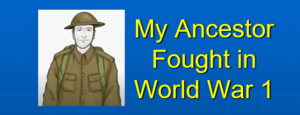We’ve made this video for those of you who had ancestors who emigrated from Britain to USA or Canada. Migration’s fascinating, why does someone leave one place and go somewhere else? There’s many motivations that may be behind a person leaving one country and going to another.
It may be what we call ‘push’ – things like war, famine, persecution or other causing them to leave; or ‘pull’, the attraction of a brave new world in the case of America, or a new life somewhere different. There are millions who over the years have gone from England, Scotland, Ireland, and Wales across to America. The Mayflower, of course, it’s the 400th anniversary this year of the Mayflower going and the successful colonisation that followed after that.
Researching Ancestors in England, Scotland, Wales & Ireland; USA & Canada
And what’s interesting with research, because of the developments in communications, we can achieve so much more in finding out, than we could in the past. Not only can we research in England and Scotland and the rest of UK, but we can also research in USA and in Canada; and that often is a very useful link and connection that we can make.
I personally am particularly passionate about this because I’ve been to North America many times, I used to work for an American company, and I had an ancestor who was on the Mayflower 400 years ago. So, what we’re going to do is show you what is involved and use examples to illustrate the sort of things that we may be able to find out on your behalf.
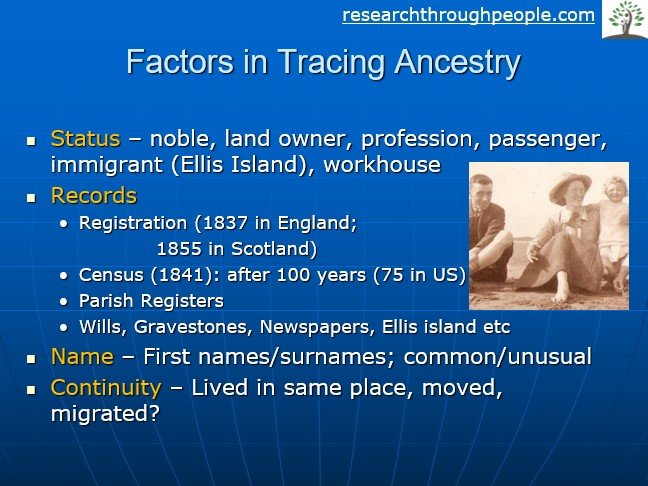
Firstly, let’s talk about the factors in tracing ancestry, and they’re the same as they are in any other situation, but there’s additional information that we may have in this case.
There are three key things: firstly, did your ancestor do something that caused people to record it? Secondly, has it survived to this day? And thirdly, can we find it?
Status
People who were noble or landowners, that tended to get recorded. But, as was the case with nobles, landowners very often, others – professions – accountants, doctors – and so on, kept records. Passenger lists have become much more available in recent years. Of course, very relevant here – we can often trace the ancestors going across from Europe to America You kept very good records – Ellis Island, of the immigrants over the years from the 19th century, very often we can trace people arriving in New York. Then, even at the other end of the scale, the workhouse kept good records.
Records.
Well, registration started in England in 1837, and 1855 in Scotland. That’s the registration of births, marriages and deaths. The census is a very key document which started in 1841, and is held every 10 years. It’s only released in the UK a hundred years out.
Whereas in USA, you release it 75 years out and that can often be quite a useful addition to our knowledge. Parish registers – before registration, it is the church parish registers that we mainly rely on. Then there’s all sorts of other things – wills, gravestones, newspapers. I mentioned Ellis Island earlier.
Name
The surname, if it’s a name like John Smith, much harder to find than if it was a very unusual surname. A big factor in how successful we are in narrowing down and finding your ancestor.
Continuity
In the old days, 200 or more years ago, people tended to stay in the same place, in the same rural area. Then as the Industrial Revolution took place, people left and went to the cities and towns for the jobs. Obviously in the case of your ancestors, they emigrated to another country. Can we track them and find them?

So let’s look at some examples.
Slade and Pierdon Ancestry
Here we have a husband and wife, their family had emigrated to Canada; both husband and wife had ancestors from Scotland and from England. There they are in Toronto. They’re born at around the time of the Second World War – we’re celebrating VE Day around now.
If we go back in time for Slade and Fleming – Slade born in Canada, but married Jesse Fleming who was born in Scotland in Dundee on the wife’s side. Both of Pierdon’s parents were born in Canada. Now we’ve left Greta Wideman – she actually had ancestors from the USA. The Slades, they came from Bristol in the West country of England.
The Flemings came from Scotland around Dundee on the East coast of Scotland. Then the Peardons came from Devon and Cornwall, the very South-West of England, and he married Margaret Dempster from Dumfries in the borders of Scotland. Going back in time, we got back to the 18th century around Bristol, Forfar, Dundee and Cornwall. So we’ve got a very interesting story building up of people from various areas coming together and eventually emigrating.
Cornwall
So let’s look at the Peardons in Cornwall in the 17th to 19th century. One of the things we tend to do in our reports is plot where the ancestors lived. It helps us to build up our understanding of where they lived and the movements, but also it helps to present a visual picture. Here you can see a situation where people didn’t move very far. These are all the places where Peardon family members are found, within a few miles of each other in Cornwall, and just over in the border with Devon.
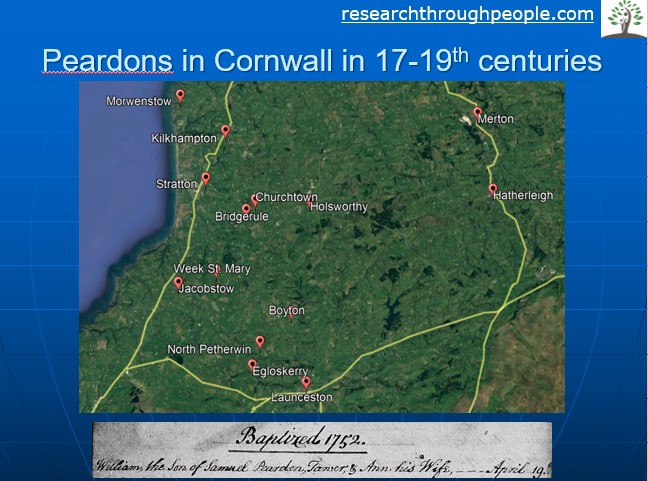
So, for 200 years, they stayed very much in the same area. I talked about parish registers – here’s a Baptism Register from 1752 for William, the son of Samuel Peardon, baptised on April 19th, 1752 in KIlkhampton. Handwriting here is fairly good – not always the case with old records, particularly going back in time.
Noble Ancestry
Now, the Noble family came from Dundee, one of the main cities in Scotland. One of the main features is the Law Hill in the middle of Dundee. The family came over from Canada and we showed them around their Ancestors’ Footsteps which you can find more info about here.
The first thing we did, we went up the top of the Law Hill and looked at the view. Now their family actually came from an area called Lochee on the West side of Dundee. We could look down on that. The River Tay, a very prominent river, flows down from Perth and is very much a feature. So, we were able to show them at the beginning of the day – a perspective of “where your ancestors lived”.
1879 Tay Bridge Disaster
Our ancestors lived through history. One of the big events in Dundee in the late 19th century was the Tay Bridge Disaster in 1879. They’d just built the new Tay Railway Bridge and some of the spans collapsed. Carriages went into the sea and 75 people were drowned.
Now, it didn’t affect the Noble family, but of course they were living there at that time. They’d have read about it, heard about it, where they were living.

They lived in Lochee. In fact, Dundee was known for three things, the three Js, Jute, Jam and Journalism. Dundee was the centre of the jute industry. The Camperdown Jute Mills were once the largest in the world and the Noble family worked in the jute mills. And we find the census where six children all work in the jute industry along with the father. They lived very close to where the mills were – mills which are no longer there.
Poverty
Another thing I mentioned was poverty in the past. Now, one of the women died when she was in her late forties. She’s left on her own and she’s a pauper – the expression that was used then – and ended up in the Poorhouse. Now the Poorhouse is no longer there, but they kept good records. We actually went to where the Poorhouse had been; and you could sense the tragedy of survival for that person.
Graveyards
It led to a graveyard which was very interesting. It can be very emotional to go and find the gravestone of an ancestor. We found where the grave was that the husband was buried in … we went and it was just like a lawn, green lawn, because he was buried in ‘common ground’. Thousands of people just buried without any record at the grave of who was there.
Lair
Now the wife had actually bought what’s called a lair in Scotland, a burial lair. Here it is, but you can see there’s no gravestone. So, she had bought the lair, but no one could afford a gravestone. It wasn’t until her son and his wife that there actually was a gravestone, but at another cemetery. Again, an example of the way our ancestors lived.
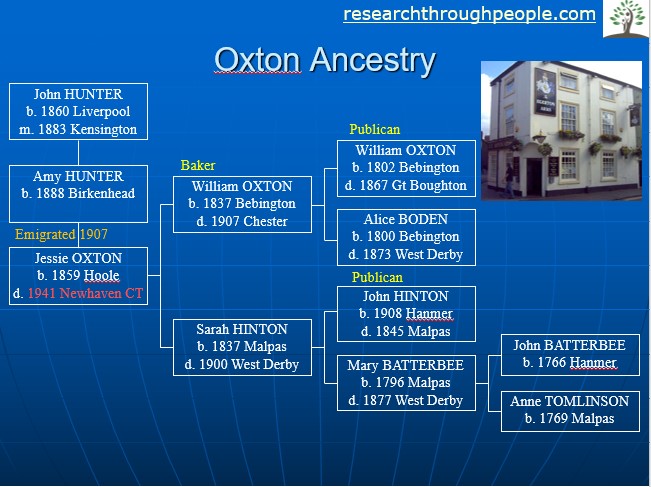
Oxton Ancestry
Now let’s take the Oxtons, whose ancestors emigrated to America. They came from England, from around Liverpool on the West coast. Here’s Jessie Oxton born in Hoole, quite near Liverpool, and she emigrated to Connecticut, in 1907. There’s her parents living quite near Liverpool, a little bit South of that and towards the border with Wales. Going back in time, again they’re all around the same sort of area within 20 or so miles of Liverpool. We got back to the 18th century.
And here we are in the mid-18th century, the Batterbees and Tomlinsons. Now, one of the interesting things that you can find out from the Census is what sort of jobs they did? So, there we are, we’ve got William Oxton and John Hinton, both publicans. So William and Sarah married, both their fathers were publicans. One of the things we were able to do was find the pub, which William Oxton had been the publican of. It was still there, and again it brings to life what our ancestors lived through. William Oxton became a baker.

A lot of housing and other buildings in the past have been demolished. But what sort of buildings are still there? Well churches typically are there, like the Bebington Parish Church. In Malpas, The Cross – there’s new and old buildings, but it still has something of the same appearance from when the Hintons lived there.
Ancestors From Liverpool
Then there’s the Port of Liverpool, one of the main ports in Britain. It brought a lot of wealth to the area and here’s a nice old painting, showing you lots of shipping and the big buildings in Liverpool. Those of you who follow football may have heard of Liverpool, one of the most famous clubs, not just in Britain, but in the world. There’s where Liverpool Football Club’s ground is, called Anfield. There are actually two football clubs in Liverpool. The other one is called Everton, the ‘Toffees’ as they’re called.
You can see the grounds are very close to each other, very fierce rivalry. The Oxtons lived in Redcar Street, very near these grounds. We found in the 1911 census an entry for them, and they emigrated in 1912 (having first gone out in 1901, then come back). So again, the story of what happened to someone’s ancestors before they went away to America.

Riddex and Dunlop Ancestry
Let’s take another example – Riddex and Dunlop in USA. Here we have Isabella Dunlop. She’s born in USA – Pennsylvania in 1885, but her parents are both born in Scotland but married in America, and Hugh Dunlop – this seems strange, well, Scotland, America, what happened? In fact, we found in 1880 US Census, the McDougals and here’s Margaret Dunlop, mother-in-law, clearly Grace’s mother, Hugh Dunlop, brother-in-law, clearly brother of Grace, and nephew, John Dunlop, the son. So, they’re born in Scotland. William McDougal’s born in England, Grace born in Scotland. Clearly they’d gone out to Pennsylvania and their children are born over in USA.
USA and Scotland
Here we have the Dunlops and we add on Isabella Dunlop born in America. She marries William Riddex, born in Ayrshire, and marries him in Ayrshire. They went out to America soon after and their daughter Annie is born in Pennsylvania in 1907.
US Records and Passenger Lists
I mentioned being able to access American ancestry records as well as English ones and Scottish ones. Here we have the actual passenger list for William and Bella Riddex going out from Glasgow to New York in 1907. Very detailed records they had then, even things about their complexion, or physical appearance. So, we were able to trace them going there. We were able to find the birth record for Annie Riddex. Here she is born in Hamilton, Pennsylvania; the father living in Morris Run, but born in Ayrshire, and the mother Isabella born in Morris Run.
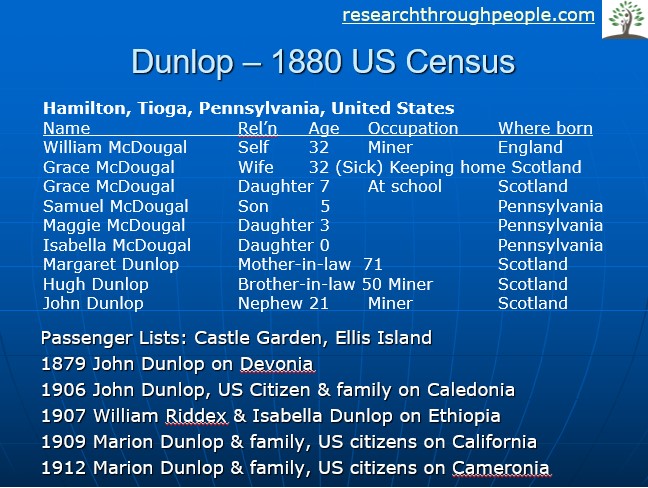
I showed you the Census earlier. Now the passenger lists – we were able to find five separate voyages made by the Dunlops and Riddexes. There’s John Dunlop going out in 1879, and going out after he’d married in 1906 and then William Riddex and Isabella Dunlop, we saw that record of the ancestors. But also, Marion and the family going out in 1909 and 1912, presumably the husband was out there, but there were something like six or seven children. I don’t know what the fares were like in those days. If they had to pay for that out of their own pocket, you would think that would be very expensive, but there we go. That gives you a flavour of various sorts of things.
Mayflower Passengers & Descendants
I mentioned the Mayflower – being the 400th anniversary this year in 2020. I like this expression “all people are living histories”. I’m sure you Americans know that there are 51 of the passengers who have known descendants, something like 35 million descendants they reckon. There are excellent books published by the General Society of Mayflower Descendants of the first five generations of those people. Well-researched. The evidence is good.
Richard Warren
I was able to buy a book for Richard Warren – my actual ancestor on the Mayflower – of five generations of his descendants. Philip Delano went out the following year and, again, there’s are books for him. The reason I am in Britain rather than USA is because, around 1785, Captain Henry Delano came back to England. So that’s why USA and Canada are very special to me.
Can We Help You Find Out About Your Ancestors?
I hope you found that interesting. At Research Through People, we’re very happy to hear from you and to see if we can help you. We give a free consultation – we want to make sure we’ve looked at things for you and come up with options. We come back to you with the options that we suggest. What’s important is that you know how much it’s going to cost; and we know how far to go with our research. We’ve currently got, for Mayflower 400, a 10% introductory discount. So, we’re very happy if you get in touch by emailing george @ researchthroughpeople .co.uk and we look forward to hearing from you. Thank you very much.


